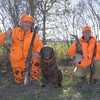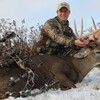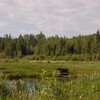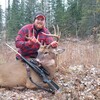
Turkey calling and Decoy placement
When a turkey gobbles on a calm spring morning, it is almost magical and screams spring in Ontario.
Who doesn’t love turkey season? It’s such an amazing time of year when the animals and people are enjoying the warm sun and watching spring pop up all around them. It’s just an exciting time to be outside.
And if you’re a turkey hunter, you anticipate all year long the day the big tom turkeys start shocking the quiet morning air with thundering gobbles, in hopes of letting every hen in the county know where he is and that he's looking for love.

I love to turkey hunt and love learning more and more about these birds. Understanding them is the best way I can explain why I hunt them the way I do and why the calling and decoy techniques work the way they do.
Wild turkeys breed in the spring, and Ontario has built their open season generally around this time. Toms, jakes, and hens all roost in trees at night. We all know this; it's Turkey 101. Before bed, each night, most toms, or one in the flock, will sound a lone gobble or two. This is done to let any hen in hearing distance know where he is. In the morning, the toms ramp it up, and from right before the crack of dawn to 30 - 45 minutes after on the roost, most toms, some jakes included, will gobble, letting hens know that here they are. Most often, they are with hens, but they are letting any others further away know as well.
Hens need the toms. Through the spring, a hen turkey will lay one or two separate clutches of eggs: two if the first one fails or gets destroyed by predators. A hen will usually lay 12 - 18 eggs in her clutch. A hen lays one to two eggs per day until her clutch is finished. She does not start sitting on them to incubate them until the final egg is laid. So each day, she needs the current egg inside her to be fertilized by a tom or jake before going and laying it, then rejoining the flock for the day or evening and night on the roost.

Understanding this helps you understand that, unlike deer, a hen is searching daily, multiple times over, for a willing partner. The tom gets away with staying with the flock of hens and not needing to search hard to find love. You not only have to trick the tom that you’re a hen, but you have to convince him most often to leave live hens.
The next stage of this process is that toms and jakes have a pecking order. They display and create dominance and competition for who gets to breed the available hen(s). One or two dominant birds control this, then the others look for what’s available after them.
Most turkey hunters hunt the morning setup. It’s the typical scenario: get in before sun-up, set up decoys, sit back and call, then hope the turkeys come. Most often, hunters find this setup challenging. The next few paragraphs will help you to up your odds of making those hunts more successful.

Find where the birds go to bed the night before and know where they want to be in the morning when they pitch down and begin to feed.
If you don’t have your spot picked to hunt them from, glass it after the birds go to bed. Once it's dark, run in and clear your spot out for either your blind or your butt against a tree. This is all in hopes of getting in undetected in the morning. If the birds hear you come in, they will often go the other way.
Set your decoys up in the dark or the night before. I like one jake and two hens, but one hen will do. A 1/4-strut jake, set right behind your one hen, implies a young bird is potentially having the opportunity to breed that hen. Place the other hen alert or feeding place 3 - 4 feet away.
Do all this within 75 - 100 yards from your roosted birds so they can see your setup from the tree once it's light.

Now, sit back and let the morning unfold. Do not, I repeat do not, start calling before the turkeys. And when the turkeys start to gobble and the hens start to cluck, do not respond to them. Let them do their natural thing. Calling early is exciting and makes the toms respond because they can't help it. But it's too early for turkeys to be on the ground screaming back; let them have 15 - 20 minutes of calling on their own, then slightly place a few soft clucks and or yelps. They will respond to you. Now, don’t call again. Let them come down naturally from their roost. Once they do, the flock will often migrate your way. The hens will want to know who the new birds are on their turf, and the toms will certainly want to know who the young jake is trying to breed a hen.
The decoys will do the rest, the birds will come in. The moral of the story: decoys, placement, and patience are the key. Magic calling is not. If they don’t come into your setup and they head the other way, then start aggressively calling them.

One last tip: if the morning setup fails or you can’t go out until later in the day. Toms get very interested between 8:30 am and 2 pm after the hens start to leave to lay eggs. Get out and call if you can get a response from a tom midday, he will work with you.
Good hunting!
Recommended Articles

Fly-in Moose Hunting

Ground Blind for Deer

Cooking Wild Game: Venison Kofta Kebabs

Buck on the Run

Cat Island Lodge

Snow Hunt for Grouse

An Unforgettable Moose Hunt by Boat

A Bear Hunt That Keeps You Coming Back
Grouse Hunting at Birch Dale Lodge

Bird Dog Friendly Lodges

Ogoki Moose

Kincardine Turkey

Father and Son

Bear Country
Goose Hunting

Bruce County Turkey

Crossing the Border into Canada

Turkey Tales and Turkey Fails

A Hunter's Dream for Grouse
















